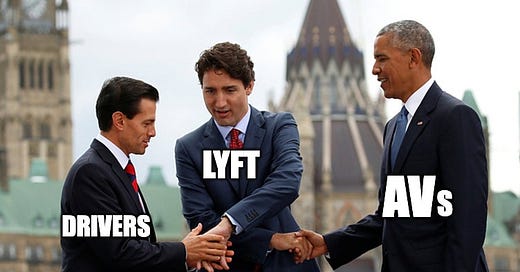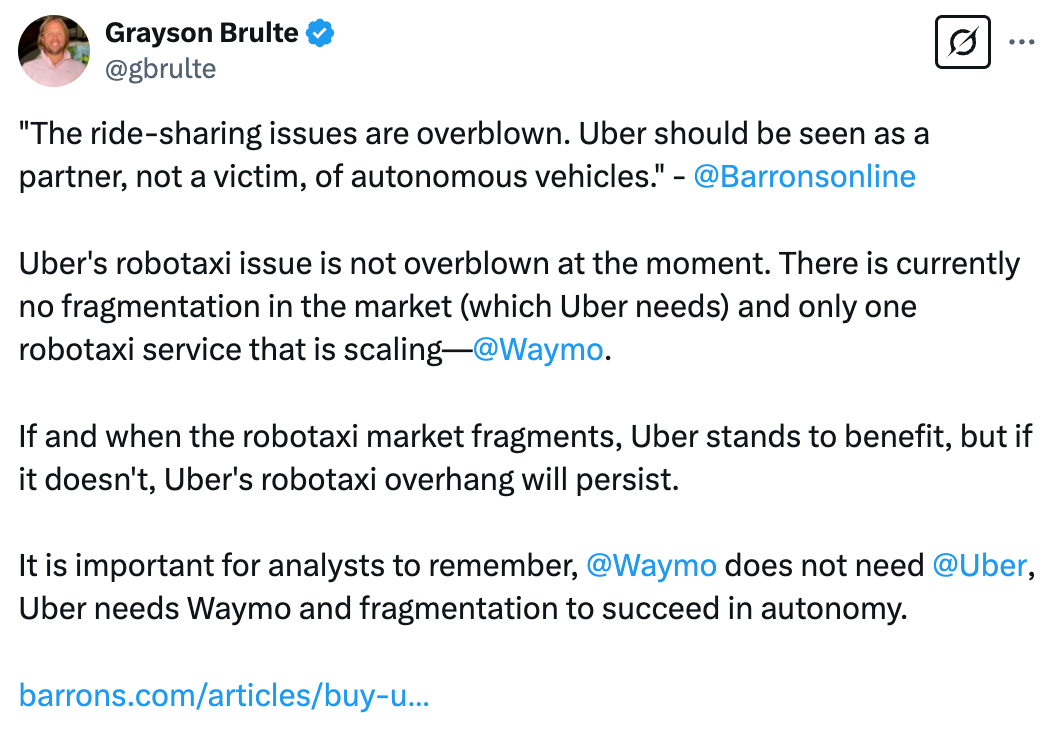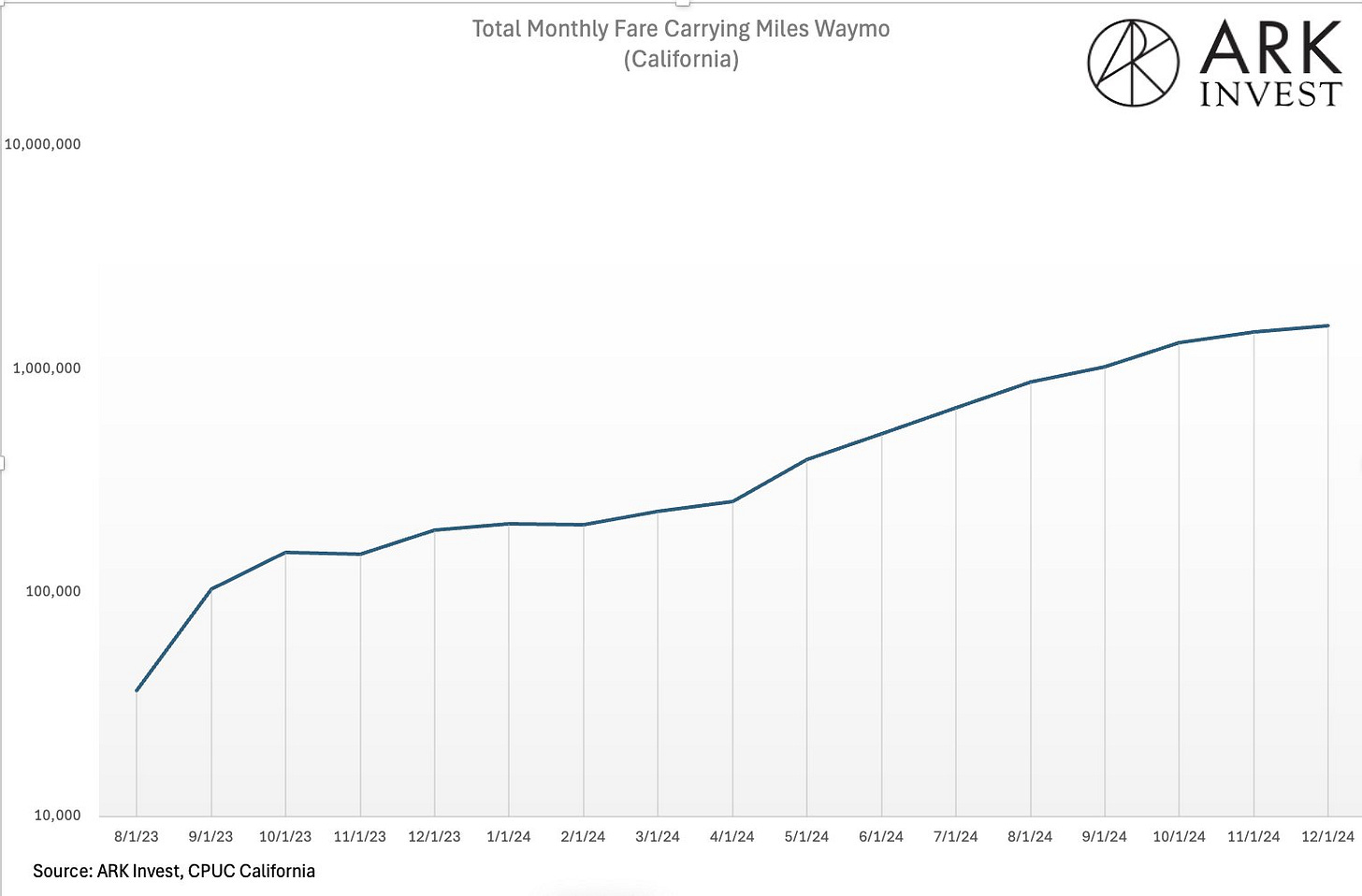Lyft's autonomous revolution 🚘🤖
Tesla to Launch Cybercabs in Austin in July, Waymo will hit the streets of Washington DC in 2026, and why Uber benefits from a fragmented AV market.
Top Stories of the Week
Lyft's autonomous revolution: Where drivers and technology move forward together (link). I have criticized Uber in the past for not thinking about drivers as they celebrate autonomy and according to a recent unscientific poll we performed, 30% of drivers in our Rideshare Guy audience said they were ‘extremely worried’ about AVs. So it was cool to see Lyft’s EVP of Driver Experience, Jeremy Bird, publish this piece.
I’ve always thought that we’d see a hybrid network of AVs and human drivers for years to come. But now that self-driving technology is finally here, it’s clear that it will take some time to scale up (the progress probably feels painstakingly slow for anyone involved in the early Uber/Lyft days).
The whole point of AVs though is to be cheaper than human powered rideshare, so in theory, this should induce more demand. But I don’t think AVs will increase the pie enough to offset the reduction in demand/earnings for human drivers. It makes sense for Uber and Lyft to replace all of their baseline demand with AVs and leave the surge times for human drivers. Typically, this is when drivers can achieve higher earnings, but if there’s less opportunity overall, and the same number of drivers, rideshare companies will be able to charge top dollar and pay drivers less.
Human drivers will be a valuable asset for years to come since they can effectively serve peak demand but their real value will lie in ownership of the asset, and not so much their driving skills. And while it’s a nice thought, I don’t think most rideshare drivers will be able to afford AVs that they can put on a rideshare network when they’re not using them.
So while I appreciate Lyft for starting the conversation on this topic, I think the opportunities for human drivers will continue to decline in the future. I’ll have a Lyft executive on my panel at
on Wednesday 4/2 in LA (there are a few discounted tickets left) so I'm looking forward to digging into this topic and more.Tesla hypes ‘unsupervised full self-driving’ launch in June: here’s what it will actually launch (link).
Waymo will launch Washington, D.C., robotaxi service in 2026 (link). Waymo continues to kill it in the PR/announcement department but it is funny that they’re announcing a launch that won’t happen until next year. This continues to be a slow and steady rollout but it’s not like they have any real competition yet so hard to blame them.
Cool Rides
I accidentally left my coffee on top of my waymo (link). Cool testament to Waymo’s smooth driving and the state of the roads in SF :)
Took my first robo ride. The future is now (link).
AVs/Humans behaving badly
Park at 90 degrees please (link). Who’s in the wrong?
APD officers move Waymo vehicles pulled over during severe weather (link). This article makes it sounds like Waymos just shut off any time there is bad weather. I can’t imagine that’s the case but then why else would they need to be moved? Either way, it’s cool that Waymo is working with first responders to give them access in situations like this. I guess that’s one downside to the no-steering wheel AV approach.
Other Stuff
The global market for autonomous vehicles is rapidly expanding and the UK is working with US companies to get these on the streets in Britain (link). I’m keeping an eye on AV developments in Europe, but based on the backlash we saw with Uber entering the market 10 years ago, I think there will be even more resistance to autonomous vehicles due to the strong support of labor. Have you ever noticed how someone (buses, trains, air traffic controllers, etc) is always on strike when you travel to Europe?
After 50 million miles, Waymos crash a lot less than human drivers (link). I've probably taken 10-15 trips in a Waymo and been pleasantly surprised at how safe they are. Obviously, this is a small sample size but I also scan the news/Twitter/Reddit/etc every week for 'Waymos behaving badly' and rarely do I see a situation where Waymo does something silly/that could lead to an accident. So this data definitely supports my anecdotal experience.
And even though it’s clear that Waymos are safe, I’m skeptical of the claim that they’ll be saving lives anytime soon. The whole point of AVs is to be cheaper than ridehail so as I mentioned earlier, this should induce more demand. Even if Waymo's get into 1/10 of the accidents, if the number of human driven miles doesn't decrease, we'd actually see an increase in injuries/deaths/etc. The only way to reduce the number of human deaths every year (over 40,000!) would be for AVs to replace human driven miles, not add more.
Tesla drops 'FSD' from the name of its smart driving software in China (link). Wouldn’t have guessed that China would crack down on this before the US. As I’ve stated before, FSD is a great Level 2 driver assistance product but by no means is it full self driving.
I like Grayson’s point here that Uber benefits in a fragmented AV market but right now, there’s only one real AV player. So does Waymo even need Uber? I still think the answer is yes because these vehicles are expensive and in order to drive the highest utilization, Uber is the best place for that (I know I sound like Dara..), without creating a negative experience for your customers. Waymo on Uber can cherry pick the best rides, lowest ETAs (Period 2), highest rated passengers and more. And those riders that Waymo ignores will still get picked up in 3 to 5 minutes by a human Uber driver. Waymo will bring costs down over time, but at that point, there will be other AV players on the scene, so I’d argue that Uber with AV + human drivers is a better service head to head than Waymo alone.
With Robotaxis, Waymo's lack of scaling aggression has been an ongoing puzzle. Yes their solution has trouble expanding into new geographies, but why not scale assets aggressively in the geographies they have mastered. The California CPUC dataset offers some clues (link). I thought of this tweet when I read about Waymo’s expansion to DC. Why expand horizontally when you still have plenty of room for growth vertically within existing markets? Some regions like LA may be a better fit for Waymo to partner with Uber since it’s more spread out while others like SF may be a better first party market for Waymo since they can keep their utilization up.
Waymo Teen is Coming 👦🧒 (link). I would put my teenage boy in Uber’s Teen product but there’s no way I’d let my teenage daughter ride with Uber. Uber can’t exactly market that so I think Waymo will have a huge leg up with this important segment. Read my case for why the Gen Alpha segment could represent a step function change in demand for rideshare companies.
I was scolded by my driverless Uber taxi (link, no paywall).
Waymo’s latest safety data in (link). After clocking over 50M miles through December 2024, they reported 83% fewer airbag deployment crashes, 81% fewer injury-causing crashes, and 64% fewer police-reported crashes compared to human drivers in Phoenix and San Francisco. Pretty solid numbers! They also racked up 5.165M, 16.032M, 28.331M, and 555K rider-only miles in LA, SF, Phoenix, and Austin, respectively.
Cybertruck Sees A “Road Runner” Fake Wall, Here’s Why (link, no paywall). This was Brad Templeton’s take on Mark Rober’s video about a Tesla crashing into an invisible wall, and he approached it from a pretty neutral perspective.
Why Waymo won’t kill Uber — but Elon Musk might (link). Was a bummer to get cut out of this interview.
Shout-outs
Thank you
for featuring our Waymo teens article in Car Charts.Thank you
for featuring The Driverless Digest in The AV Market Strategist.Thanks to Marisa M and Marisa S for referring new subscribers this past week!
🚨🎟️Contest Alert: I’ve got two free tickets to Ride AI for the top 2 referrers between now and Monday morning - will reach out to the winners via e-mail on Monday morning :) Cory K already earned one free ticket as the top all time referrer! Hit the button below and/or forward this e-mail to refer a friend who would enjoy The Digest!
Until next week.
-Harry







Appreciate your perspective as always Harry!
I have a theory about why Waymo isn't scaling as fast as expected in SF. I think that to people who are not already AV enthusiasts like you or I, the added value between Waymo and rideshare just isn't as much right now as the added value of both lower prices and convenience that rideshare had relative to traditional taxis in the 2010s. I wrote more about this here:
https://www.2120insights.com/p/how-autonomous-vehicles-will-change
With this in mind, it makes sense that Waymo would prioritize putting their cars in more cities rather than deepening their market share-- first-mover advantage among the "AV enthusiast" market is more important than deepening market share among a skeptical public for now.
The incentives may change once Waymo can compete on price, and I'm curious what your thoughts are on my breakdown of the unit economics of Waymo vs. Uber that I explored in my above piece ^
Thank you for the Shout-out, Harry!